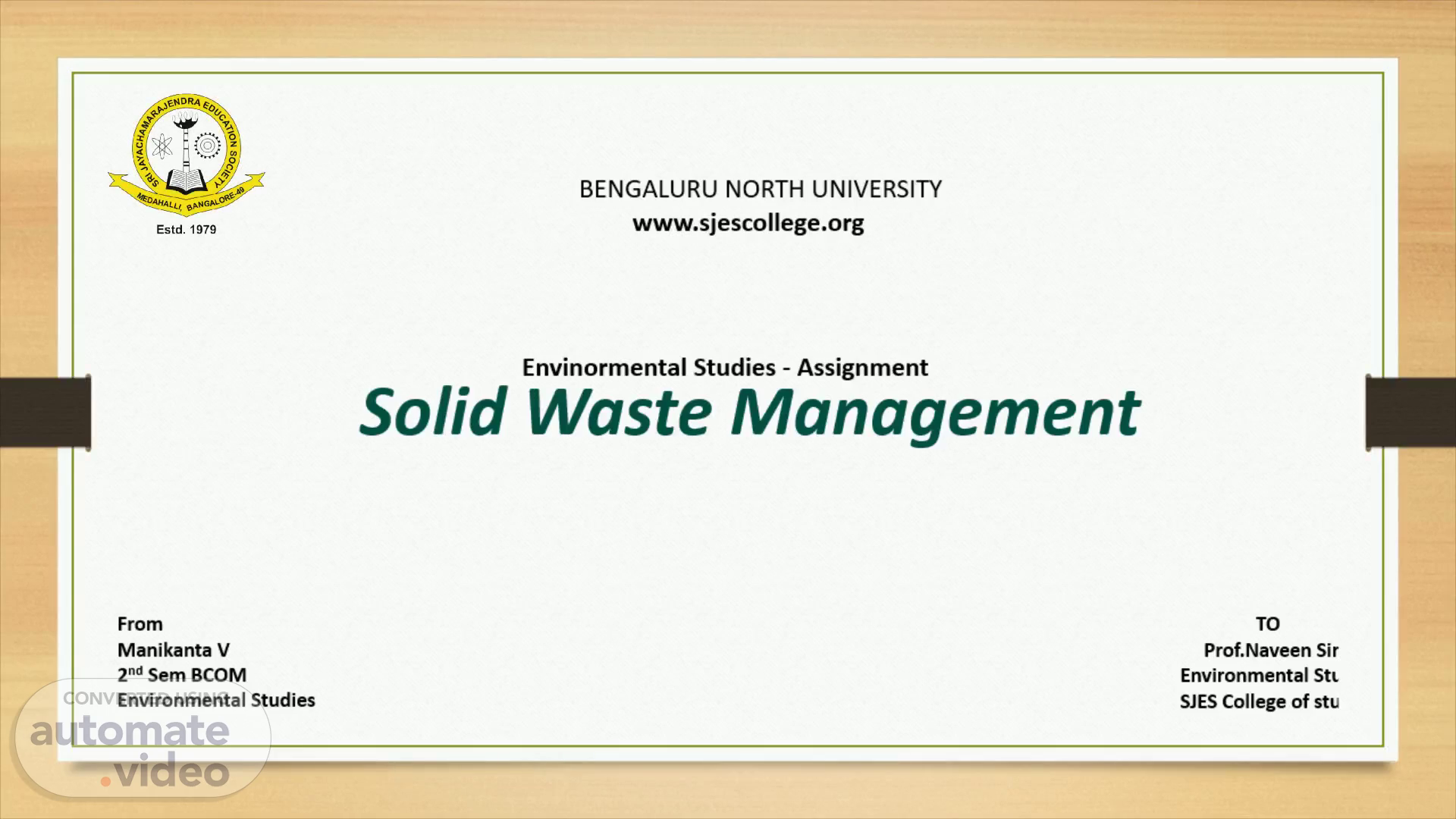
Page 1 (0s)
BANGALOR€. SJES COLLEGE OF MANAGEMENT OF STUDIES.
Page 2 (13s)
SL.No Topic Page No 01 Waste Meaning & Its Management 01 02 Introduction 02 03 04 05.
Page 3 (23s)
Solid Waste Management In Rural Areas of India.
Page 4 (39s)
SOLID WASTE AND ITS MANAGEMENT. It is defined as: Waste (also known as rubbish , trash , refuse , garbage , junk ) is any unwanted or useless materials. OR “Any materials unused and rejected as worthless or unwanted” and “A useless or profitless activity; using or expending or consuming thoughtlessly or carelessly”.
Page 5 (1m 0s)
INTRODUCTION. Since the beginning, Human kind has been generating waste. It could be in the form of: Other parts of animals they slaughter Bones Wood With the progress of civilization the waste generated became of a more complex nature. At the end of 19 th century (Industrial revolution) there was rise in the world of consumers. The increase in population and urbanization was also largely responsible for the increase in solid waste.
Page 6 (1m 25s)
TYPES OF WASTE. Solid Waste Liquid Waste Gaseous Wastes Animal by-products Biodegradable waste Biomedical waste Bulky waste Business waste Solid wastes also include: Sewage sludge Agricultural refuse Mining residues Demolition wastes.
Page 7 (1m 38s)
SOLID WASTE. Types of Liquid Waste Domestic Sewage. Domestic sewage waste refers to the waste and products from a residential septic tank. ... Domestic Holding Tank Waste. Domestic holding tank waste is waste pumped from a sealed tank that doesn't have a drain field. ... Commercial Wastewater. ... Industrial Waste. ... Runoff Waste..
Page 8 (2m 9s)
Municipal solid waste consists of: Household waste Sanitation residue Waste from streets Construction and demolition debris.
Page 9 (2m 19s)
Characterization Of Municipal Solid Waste* Vud Trimmir•gs 12.0% Piasbcs 11.2% • Prot•abn in The (EP_A53ER42401) June.
Page 10 (2m 42s)
The type of litter we generate and the approximate time it takes to degenerate Type of litter Approximate time it takes to degenerate the litter Organic waste such as vegetable and fruit peels, leftover foodstuff, etc A week or two. Paper 10–30 days Cotton cloth 2–5 months Wood 10–15 years Woolen items 1 year Tin, aluminum, and other metal items such as cans 100–500 years Plastic bags one million years Glass bottles undetermined.
Page 11 (3m 3s)
HAZARDOUS WASTE. I ndustrial and hospital waste is considered hazardous as they may contain toxic substances. Hazardous wastes could be highly toxic to humans, animals, and plants. They are Corrosive Highly inflammable, or explosive React when exposed to certain things e.g. gases Household wastes that can be categorized as hazardous waste include: old batteries shoe polish paint tins old medicines.
Page 12 (3m 23s)
HOSPITAL WASTE. Hospital waste is generated during the diagnosis, treatment, or immunization of human beings or animals It may include wastes like Sharps Cultures Soiled waste Chemical wastes Anatomical waste Discarded medicines.
Page 13 (3m 36s)
SOURCES AND OTHER TYPES OF WASTE. Source Typical Waste Generators Types of solid wastes 1:Residential Single and multifamily dwellings Food wastes Paper Cardboard Plastics Textiles Leather Yard wastes Wood Glass Metals Ashes Special wastes ( e.g bulky items, consumer electronics, white goods, batteries, oil, tires), and household hazardous wastes.).
Page 14 (3m 53s)
2: Industrial Light and heavy manufacturing, fabrication, construction sites, power and chemical plants. Housekeeping wastes Packaging Food wastes Construction and demolition materials Hazardous wastes Ashes Special wastes. 3:Commercial Stores, hotels, restaurants, markets, office buildings, etc. Paper cardboard plastics wood food wastes glass metals special wastes hazardous wastes 4: Institutional Schools,hospitals,prisons, government centers. Same as commercial..
Page 15 (4m 14s)
5:Construction and demolition New construction sites, road repair, renovation sites, demolition of buildings Wood steel concrete dirt etc. 6:Municipal services Street cleaning, landscaping, parks, beaches, other recreational areas, water and wastewater treatment plants. Street sweepings landscape and tree trimmings General wastes from parks Beaches Recreational areas; sludge. 7:Process (manufacturing etc.) Heavy and light manufacturing, refineries, chemical plants, power plants, mineral extraction and processing. Industrial process wastes Scrap materials Off-specification products. 8:Agriculture Crops, orchards, vineyards, dairies, feedlots, farms. Spoiled food wastes Agricultural wastes Hazardous wastes (e.g., pesticides)..
Page 16 (4m 44s)
Composting is carried out in a simple manure pit or garbage pit (lined or unlined). In this process aerobic microorganisms oxidize organic compounds to carbon- dioxide and oxides of nitrogen and carbon from organic compounds is used as a source of energy, while nitrogen is recycled. In the composting process, due to exothermic reactions, temperature of mass rises. In areas/regions with higher rainfall composting in over ground heaps is advisable. The factors affecting the composting process are: (a) Micro-organisms; (b) Moisture, (c) Temperature and (d) Carbon/ Nitrogen (C/N) ratio.
Page 17 (5m 10s)
Image result for waste Thank you slide.